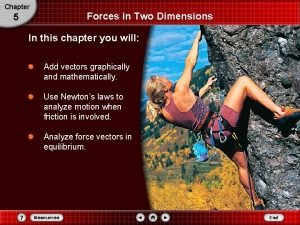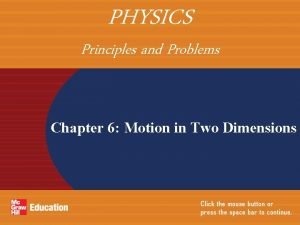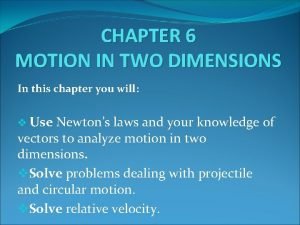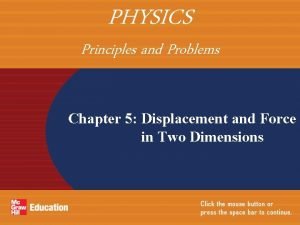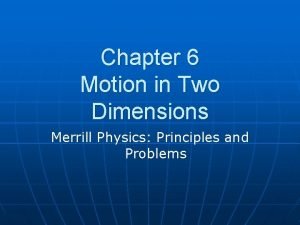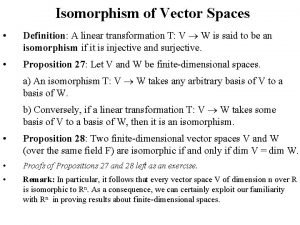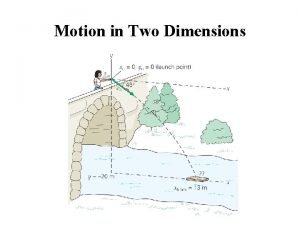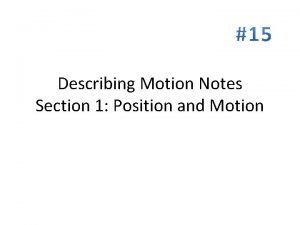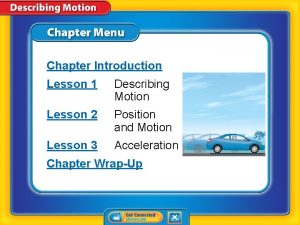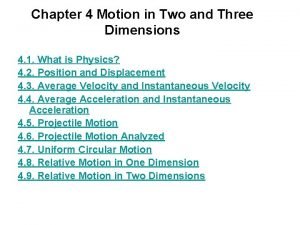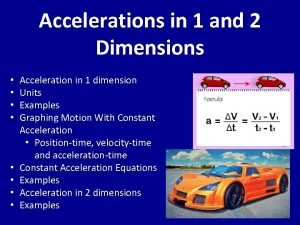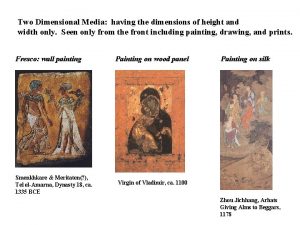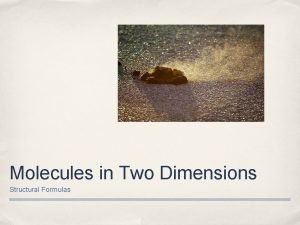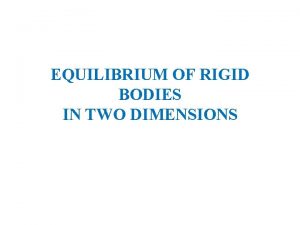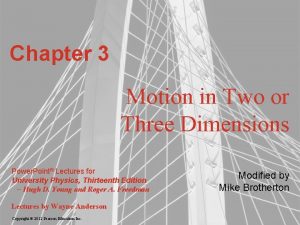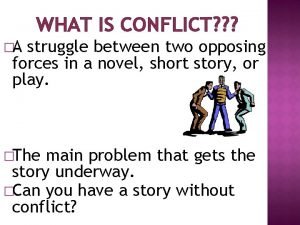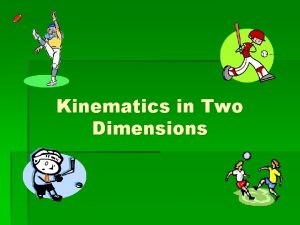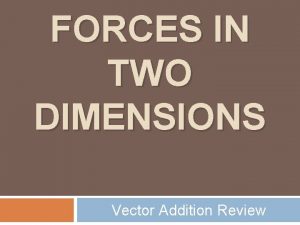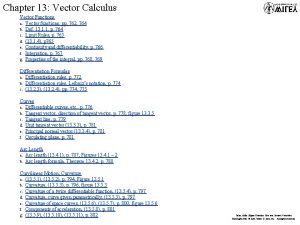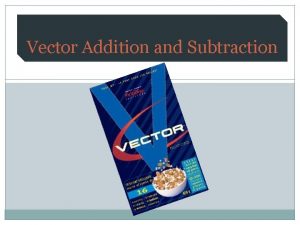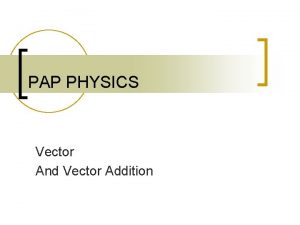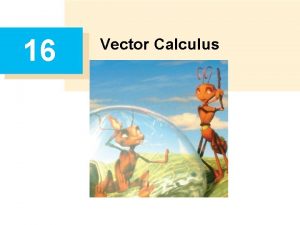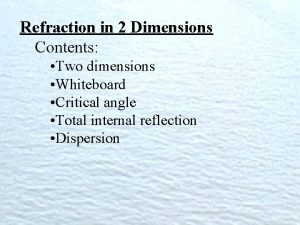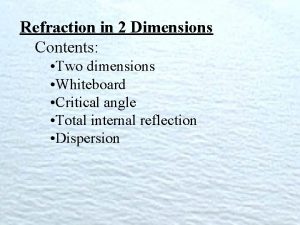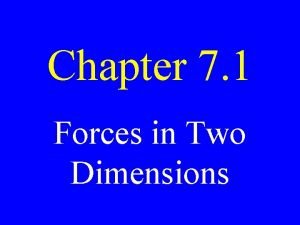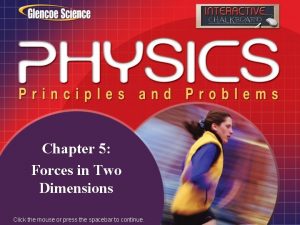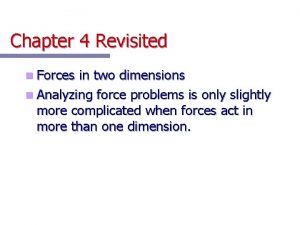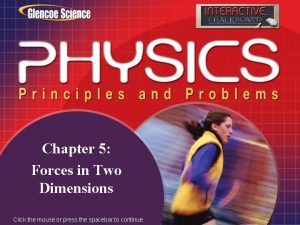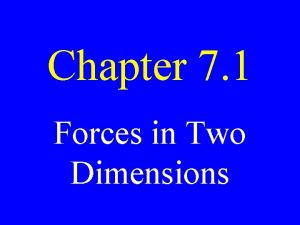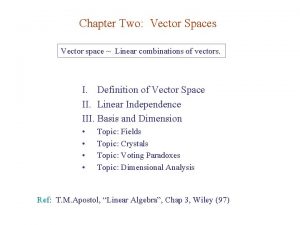Chapter 5 Forces in Two Dimensions Vector vs




































- Slides: 36

Chapter 5 Forces in Two Dimensions

Vector vs. Scalar Review

Vector vs. Scalar Review All physical quantities encountered in this text will be either a _____ or a ______. A vector quantity has both ____ (size) and ____. ◦ Add/subtract vectors require special rules A scalar is completely specified by only a _____ (size). ◦ Add/subtract vectors require no special rules

Vector Notation When handwritten, use an arrow: When printed, will be in bold print with an arrow: When dealing with just the magnitude of a vector in print, an italic letter will be used: A ◦ Italics will also be used to represent scalars

Properties of Vectors Equality of Two Vectors ◦ Two vectors are ____if they have the same magnitude and the same direction. ◦ These are parallel rays. Movement of vectors in a diagram ◦ Any vector can be moved _____ to itself without being affected.

More Properties of Vectors Negative Vectors ◦ Two vectors are negative if they have the same _______ but are _____(opposite directions). ◦ Resultant Vector ◦ The ____ vector is the sum of a given set of vectors. ◦

Parallel Vectors A B These two vectors are equal. A B These two vectors are not equal.

Adding Vectors When adding vectors, their ____ must be taken into account. Units must be the same. Geometric Methods ◦ Use scale drawings Algebraic Methods ◦ More convenient ◦ More on this later

Adding Vectors Geometrically (Triangle Method) Choose a scale Draw the first vector with the appropriate length and in the direction specified, with respect to a coordinate system Draw the next vector using the same scale with the appropriate length and in the direction specified, with respect to a coordinate system whose origin is the end of vector and parallel to the coordinate system used for.

Graphically Adding Vectors Continue drawing the vectors “____” The resultant is drawn from the origin of to the end of the last vector Measure the length of and its angle ◦ Use the scale factor to convert length to actual magnitude.

Graphically Adding Vectors When you have many vectors, just keep repeating the process until all are included. The resultant is still drawn from the origin of the first vector to the end of the last vector.

Sample Problem Find the magnitude of the sum of a 15 km displacement and a 5 km displacement when the angle between them is 90 o and when the angle between them is 135 o. Use the graphical method of addition.

Notes about Vector Addition Vectors obey the ________ Law of Addition ◦ The order in which the vectors are added doesn’t affect the result ◦

Sample Problem A car travels 20 km due north and then 35 km in a direction 60 o west of north. Find the magnitude and direction of a single vector that gives the net effect of the car’s trip. This vector is called the car’s resultant displacement.

Vector Subtraction Special case of vector addition: ◦ Add the negative of the subtracted vector Continue with standard vector addition procedure

Components of a Vector A component is a _______. It is useful to use rectangular components ◦ These are the projections of the vector along the xand y-axes.

Components of a Vector The x-component of a vector is the projection along the ____: The y-component of a vector is the projection along the _____: Then,

More About Components of a Vector The previous equations are valid only if ____ is measured with respect to the _______. The components can be positive or negative and will have the same units as the original vector. We can use various trig. functions to solve for the length and angle of the resultant.

More About Components The components are _________ whose hypotenuse is ◦ May still have to find θ with respect to the positive xaxis. ◦ The value will be correct only if the angle lies in the first or fourth quadrant.

Trig. and Vectors Trig. Ratios: Law of Cosines: ◦ R 2 = A 2 + B 2 – 2 ABcosθ ◦ R =resultant vector ◦ A/B = two vectors added together ◦ Θ = angle between A and B Law of Sines:

Adding Vectors Algebraically Choose a coordinate system and sketch the vectors. Find the x- and y-components of all the vectors. Add all the x-components ◦ This gives Rx:

Adding Vectors Algebraically Add all the y-components ◦ This gives Ry: Use the _______ to find the magnitude of the resultant: Use the ________to find the direction of R:

Sample Problem A GPS receiver indicates that your home is 15. 0 km and 40. 0 o north of west, but the only path through the woods leads directly north. If you follow the path 5. 0 km before it opens into a field, how far, and in what direction, would you walk to reach your home?

Forces of Friction When an object is in motion on a _______ or through a _______, there will be a resistance to the motion. ◦ This is due to the interactions between the object and its environment. ◦ The “viscous” mediums include water or air. This is resistance is called _____. ◦ Static friction ◦ Kinetic friction Friction plays an important role in our daily lives. ◦ Friction allows us to run and walk and allows the wheels on our cars to move the car.

More About Friction is _______ to the _______. The force of static friction is generally ____ than the force of kinetic friction. The direction of the frictional force is _____ the direction of motion. The ________(µ) depends on the surfaces in contact. The coefficients of friction are nearly _____ of the _______.

Static Friction, ƒs Static friction acts to keep the object from moving. ◦ As long as F = ƒs no motion occurs. ◦ When F >ƒs motion occurs. ƒs arises from the nature of the two surfaces in contact with each other. ◦ µs accounts for this ƒs µ s n ◦ This gives us the magnitude of the force of static friction. ◦ Use = sign for impending motion only.

Static Friction, ƒs If F increases, so does ƒs If F decreases, so does ƒs ƒs, max is the maximum limit to the force of static friction. ◦ When an object is in motion the friction force is less than the ƒs, max

Kinetic Friction, ƒk The force of kinetic friction acts when the object is in motion. Fnet = F – ƒk At constant velocity (a = 0): ◦ F = ƒk If F=0 ◦ ƒk will provide an acceleration in the direction opposite of the movement and eventually bring the object to rest. ƒk = µ k n ◦ Variations of the coefficient

Sample Problem You push a 25. 0 kg wood box across a wooden floor at a constant speed of 1. 0 m/s. How much force do you exert on the box? Use Table 5. 1 (p. 129) to help you solve this problem.

Some Coefficients of Friction

Friction and the Motion of a Car Friction plays an important role in the movement of a car. Friction between the moving car’s wheels and the road is static friction. ◦ This moves the car forward. ◦ Unless the car is skidding. Also have the air resistance, ◦ This slows the car down

Equilibrium An object either at rest or moving with a constant velocity is said to be in ______. The ____acting on the object is zero (since the acceleration is zero. )

Equilibrium Easier to work with the above equation in terms of its components: This could be extended to three dimensions. ◦ We would also have to consider ΣFz = 0 A zero net force does not mean the object is not moving, but that it is not accelerating.

Inclined Planes Problems These are important and common types of problems here and y elsewhere. Choose the coordinate system with x along the incline and y perpendicular to the incline Replace the force of gravity with its components. ◦ Fg itself must remain perpendicular to the ground. n x FG 0 y W 0 W x W

Sample Problem A crate weighing 562 N is resting on a plane inclined 30. 0 o above the horizontal. Find the component of the weight forces that are parallel and perpendicular to the plane.

Chapter 5 THE END Forces in Two Dimensions
 Chapter 5 forces in two dimensions worksheet answers
Chapter 5 forces in two dimensions worksheet answers Chapter 6 study guide motion in two dimensions
Chapter 6 study guide motion in two dimensions A 45-kg merry-go-round worker
A 45-kg merry-go-round worker Chapter 6 motion in two dimensions
Chapter 6 motion in two dimensions Displacement and force in two dimensions
Displacement and force in two dimensions Chapter 6 motion in two dimensions
Chapter 6 motion in two dimensions Isomorphism vector space
Isomorphism vector space Unit vector examples
Unit vector examples Suma de dos vectores
Suma de dos vectores How is vector resolution the opposite of vector addition
How is vector resolution the opposite of vector addition Position vector definition class 11
Position vector definition class 11 Like parallel forces and unlike parallel forces
Like parallel forces and unlike parallel forces The forces shown above are
The forces shown above are Intra vs intermolecular forces
Intra vs intermolecular forces Similarities of intermolecular and intramolecular forces
Similarities of intermolecular and intramolecular forces Inter vs intramolecular forces
Inter vs intramolecular forces Contact forces
Contact forces Unbalanced force
Unbalanced force Is deposition constructive or destructive
Is deposition constructive or destructive Acceleration in two dimensions
Acceleration in two dimensions Two dimensions of political ideologies
Two dimensions of political ideologies Projectile motion displacement formula
Projectile motion displacement formula Position and motion
Position and motion Describing position in two dimensions
Describing position in two dimensions Motion in two and three dimensions
Motion in two and three dimensions Dimension of acceleration
Dimension of acceleration Two dimensional media
Two dimensional media Molecules in two dimensions structural formulas
Molecules in two dimensions structural formulas Equilibrium of rigid bodies in two dimensions
Equilibrium of rigid bodies in two dimensions Chapter 6 strategy analysis and choice
Chapter 6 strategy analysis and choice Motion in two or three dimensions
Motion in two or three dimensions Two dimensions of spiral model
Two dimensions of spiral model Motion in two dimensions quick check
Motion in two dimensions quick check A cart slows down while moving away from the origin
A cart slows down while moving away from the origin Lanczos
Lanczos A struggle between two opposing forces
A struggle between two opposing forces Divided into two types
Divided into two types
